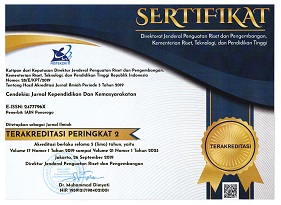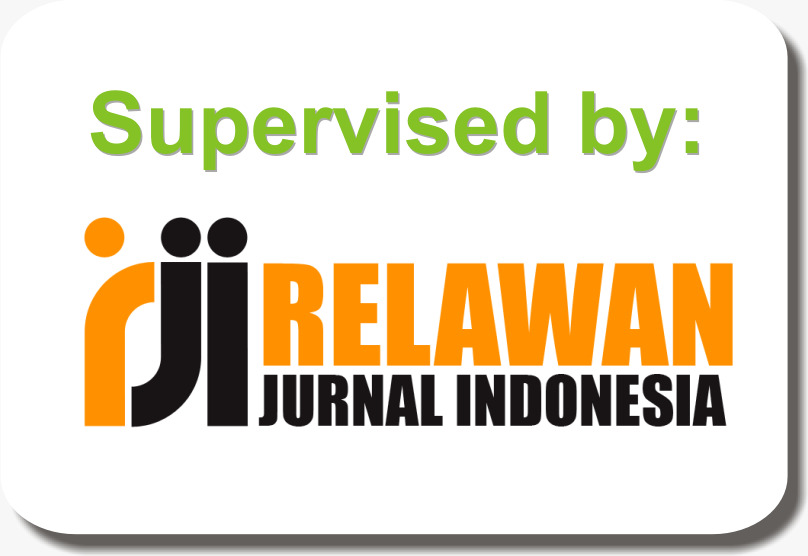Eksistensi Pendidikan Pesantren dalam Arus Perubahan
DOI:
https://doi.org/10.21154/cendekia.v16i2.1242Keywords:
Eksistensi Pendidikan Pesantren, Arus PerubahanAbstract
Rapid change, demanding the ability of pesantren to respond quickly, precisely, and adaptively.In this paper talks about the existence of pesantren education in the face of the flow of change. This research is focused on the existence conducted by As-Shafi'i boarding school (pesantren) in the flow of change. The approach used in this study is a case study experienced by remote educational institutions that boarding boarding schools As-syafi'I in existence maintain the institution of boarding school. The theory used in this study uses Talcott have four things called AGIL: Adaptation Goal attainment, Integration, Latency. Concluded that the existence of pesantren education in the flow of change as follows; Thefirst adaptation conducted by the boarding school As-Syafi'I is to know in detail the existing needs in the community. Second, the development of personality aims to prepare the students and the public to have the knowledge of religion and general science in order to become human beings who are able to practice their knowledge. Third, integrating and integrating school and pesantren systems Thefour patterns of As-Syafi'I boarding school institutions are building networking with all components of society, santri guardian, government in building pesantren.
قد طلب التغير السريع بقدرة المدرسةالداخلية على الاستجابة بسرعة ودقة وتكيÙ. تتØدث هذه الكتابةعن وجود تعليم المدرسةالداخليةÙÙŠ مواجهة تدÙÙ‚ التغيير. Ùˆ يركز هذا البØØ« على وجود مدرسة الشاÙعي الداخلية ÙÙŠ تدÙÙ‚ التغيير. وأما المنهج المستخدم ÙÙŠ هذه الدراسة هو دراسة Øالة ÙÙŠ مؤسسة التعليمية النائية ØŒ وهي مدرسة الشاÙعي الداخلية ÙÙŠ اØتÙاظ وجودهاكالمؤسسة التربوية الإسلامية الداخلية. Ùˆ تستخدم هذه الدراسةالنظرية التي تقدمت بها تلكوت Ùيرسونو قيل لكييستطيع نظام التنظيم الاجتماعي أنيØتÙظ وجودهÙيجب أن يكون النظام له أربعة أشياء تسمى(AGIL) Ùˆ هيالتكي٠(adaptation) Ùˆ تØقيق الأهدا٠(goalattainment)Ùˆ التكامل (integration) Ùˆ التأخر (latency).Ùˆ من نتائج الدراسة يستطيع الباØØ« أن يستنتجبأن وجود التربيةÙيالمدرسةالداخليةÙÙŠ تدÙÙ‚ التغيير هو على النØÙˆ التالي : أولا، التكيي٠الذي أجرته المدرسة الشاÙعي الداخلية هو معرÙØ© اØتياجات المجتمع الØالية بالطريقة المباشرة. Ùˆ ثانياً، يهد٠تدريب الشخصية إلى إعداد الطلاب والمجتمعلأن يتقنو المعرÙØ© الدينية والمعرÙØ© العامة لكي يصبØÙˆ الناس الذينلهمقدرة على ممارسة معرÙته. Ùˆ ثالثًا، وإدماج العامة ونظامالمدرسةالداخلية لإنتاج أجيال موثوقةÙÙŠ Øقولهم. Ùˆ رابعًا، الأنماط التي تنÙذها المدرسة الشاÙعي الداخلية هي بناء التواصل مع جميع المكونات Ùˆ هم المجتمع وأولياء الطلاب والØكومة لبناء المدارس Ùˆ تقدمه. بالإضاÙØ© إلى ذلك، Ùإن الاستثمار الاجتماعي للبرنامج الداخلي هو من نشاطالمدرسة الشاÙعي الداخلية الذي يهد٠إلى خلق الجيل المستقل المÙيد ÙÙŠ الØياة المجتمعية ÙÙŠ وقت مستقبل.
Downloads
Published
Issue
Section
License
Copyright & License
Please find the rights and licenses in Cendekia: Jurnal Kependidikan dan Kemasyarakatan. By submitting the article/manuscript, the author(s) agree with this policy. No specific document sign-off is required.
1. License
The non-commercial use of the article will be governed by the Creative Commons Attribution license as currently displayed on the Creative Commons Attribution-NonCommercial 4.0 International License.
2. Author(s)' Warranties
The author warrants that the article is original, written by the stated author(s), has not been published before, contains no unlawful statements, does not infringe the rights of others, is subject to copyright that is vested exclusively in the author and free of any third party rights, and that any necessary written permissions to quote from other sources have been obtained by the author(s).
3. User/Public Rights
The spirit of Cendekia: Jurnal Kependidikan dan Kemasyarakatan is to disseminate articles published as free as possible. Under the Creative Commons license, Cendekia: Jurnal Kependidikan dan Kemasyarakatan permits users to copy, distribute, display, and perform the work for non-commercial purposes. Users will also need to attribute authors and Cendekia: Jurnal Kependidikan dan Kemasyarakatan on distributing works in the journal and other media of publications. Unless otherwise stated, the authors are public entities as soon as their articles got published.
4. Rights of Authors
Authors retain all their rights to the published works, such as (but not limited to) the following rights;
- Copyright and other proprietary rights relating to the article, such as patent rights,
- The right to use the substance of the article in own future works, including lectures and books,
- The right to reproduce the article for own purposes,
- The right to self-archive the article,
- The right to enter into separate, additional contractual arrangements for the non-exclusive distribution of the article's published version (e.g., post it to an institutional repository or publish it in a book), with an acknowledgment of its initial publication in this journal (Cendekia: Jurnal Kependidikan dan Kemasyarakatan).
5. Co-Authorship
If the article was jointly prepared by more than one author, any author submitting the manuscript warrants that he/she has been authorized by all co-authors to be agreed on this copyright and license notice (agreement) on their behalf and agrees to inform his/her co-authors of the terms of this policy. Cendekia: Jurnal Kependidikan dan Kemasyarakatan will not be held liable for anything arising due to the author(s) internal dispute. Cendekia: Jurnal Kependidikan dan Kemasyarakatan will only communicate with the corresponding author.
6. Royalties
Being an open accessed journal and disseminating articles for free under the Creative Commons license term mentioned, the author(s) are aware that Cendekia: Jurnal Kependidikan dan Kemasyarakatan entitles the author(s) to no royalties or other fees.
7. Miscellaneous
Cendekia: Jurnal Kependidikan dan Kemasyarakatan will publish the article (or have it published) in the journal if the article's editorial process is completed. The editors of Cendekia: Jurnal Kependidikan dan Kemasyarakatan may modify the paper to a style of punctuation, spelling, capitalization, referencing, and usage that deems appropriate. The author acknowledges that the article may be published so that it will be publicly accessible, and such access will be free of charge for the readers, as mentioned in point 3.

















